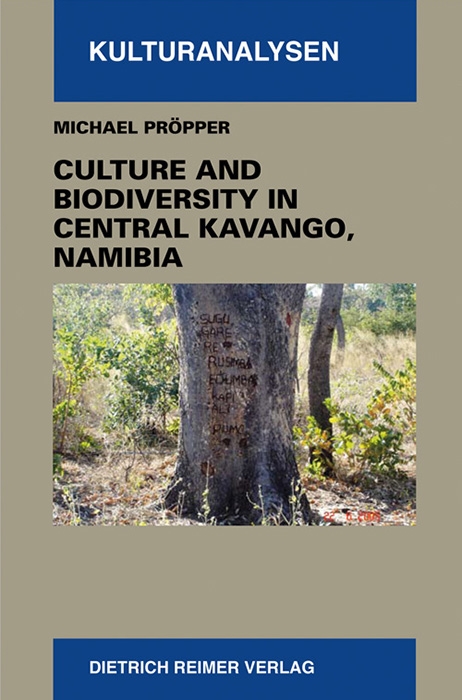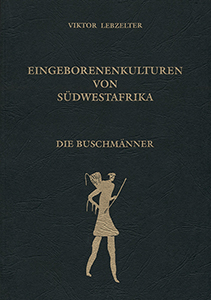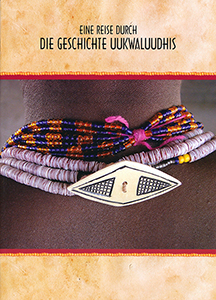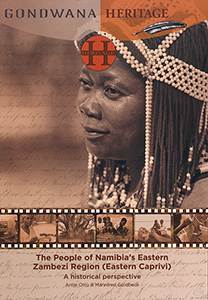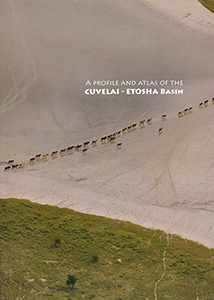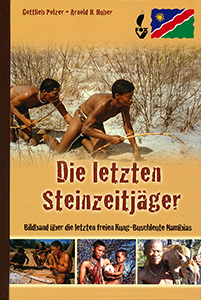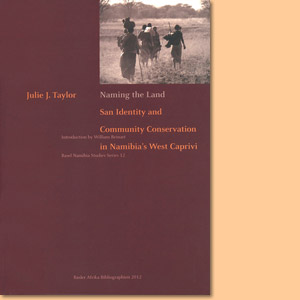Culture and Biodiversity in Central Kavango, Namibia, by Michael Pröpper
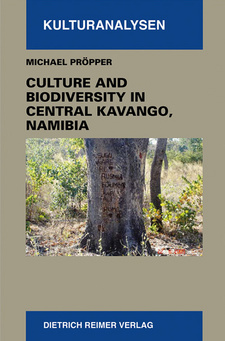
Culture and Biodiversity in Central Kavango, Namibia, by Michael Pröpper. Dietrich Reimer Verlag. Berlin, 2009. ISBN 9783496028277 / ISBN 978-3-496-02827-7

Culture and Biodiversity in Central Kavango, Namibia (Michael Pröpper)
Michael Pröpper investigates how the culture of the inhabitants of Ave villages in the central Kavango region of Namibia influences their thinking and actions relating to the biodiversity and surrounding dry forest savannah, an ecosystem that is coming under increasing pressure from anthropogenic overuse.
Table of content: Culture and Biodiversity in Central Kavango, Namibia, by Michael Pröpper
OPENING SECTION
1 Introduction
1.1 Problem, questions and objectives
1.2 Outline and structure of the book
1.3 Dimensions of human-biodiversity interaction
1.3.1 Biodiversity, environment, resources
1.3.2 Actors, culture, interaction
1.3.3 A cultural - social - ecological system
1.4 Methodology: Realizing interaction research
1.4.1 Overview and general methodology
1.4.2 Census
1.4.3 Cultural actors: Seeing and knowing the environment...
1.4.4 ... deciding and acting
2 Kavango setting and situation
2.1 Climatic, geographic and biotic environment
2.2 Status of Kavango ethnographic sources
2.3 Some central aspects of a history of Kavango people
2.3.1 Sources
2.3.2 Historic overview
2.4 Kavango today
2.4.1 Borders
2.4.2 Ethnicity
2.4.3 Languages
2.4.4 Problems and challenges
2.5 The Research situation and 'field'
EMPIRICAL PART 1:
'DIRECT' HUMAN-BIODIVERSITY INTERACTION
3 Demography and biodiversity: A census point of view
3.1 The Kavango census
3.2 The territorial census sample
3.3 Census data and the household as a unit of analysis
3 4 Census data quality assessment
3.5 Census data
3.5.1 Census samples composition
3.5.2 Ethnicity
3.6 Village level demography
3.6.1 Population
3.6.2 Villages and ethnic affiliation
3.6.3 Age-Distribution
3.6.4 Fertility
3.6.5 Mortality and life expectancy
3.6.6 Natural population development
3.6.7 Migration
3.6.7.1 Inward migration
3.6.7.2 Inward migration patterns and history
3.6.7.3 Outward migration
3.6.7.4 Ethnic component of temporary out-migration
3.6.7.5 Summary on migration
3.6.8 Population growth and pressure on resources
3.7 Household level demography
3.7.1 Household sizes and composition
3.8 Summary: Demography and biodiversity impact
4 Environmental knowledge, use-forms and impacts
4.1 Mental concepts of the environment
4.2 Structures of botanical knowledge
4.2.1 Domain specific freelisting
4.2.2 Central findings
4.2.2.1 'Most important wild plants'
4.2.2.2 Crops and garden plants, vegetables
4.3 Use forms and their impacts
4.3.1 Agriculture and clearing
4.3.1.1 Clearing of trees and bushes
43.12 Clearing of grasses and unwanted species
4.3.2 Harvesting of natural resources
4.3.2.1 Harvesting of wood
4.3.2.2 Harvesting of grasses
4.3.2.3 Harvesting of fruits and medicinal plants
4.3.3 The impact of human induced fires
4.4 Exemplary correlations of botanical salience and uses
4.4.1 Trees and bushes
4.4.2 Wild fruits
4.4.3 Healing plants
4.4.4 Crops
4.5 Synthesis on botany and impact
4.6 Structures of zoological knowledge
4.6.1 Knowledge, uses and impact situation on fauna
4.7 Soils
4.8 Water
4.9 Summary: Utilitarism and biodiversity as natural capital
5 Domestic economy and natural capital
5.1 Units of economic analysis
5.1.1 Households
5.1.2 Individual actors within households
5.2 Forms of capital
5.2.1.1 Households' physical capital and wealth
5.2.1.2 Financial capital: Labour income, remittances, pensions, credits
5.2.1.3 Individuals, cultural/human capital and education
5.3 Production and biodiversity
5.3.1 The cultivation system
5.3.1.1 Rainfall levels
5.3.1.2 Household land: Fields for agriculture
5.3.1.3 Knowledge, skills and natural capital
5.3.1.4 Households' and actors' agricultural labour input
5.3.1.5 Households' agricultural productivity
5.3.1.6 Community and collective production
5.3.2 Pastoralism: Security through livestock farming
5.3.3 Diversification and cash: Extracting products
5.4 Distributing natural resources and products
5.4.1 Distribution of agricultural products
5.4.2 Exchanging livestock
5.4.3 Resource distribution
5.5 Domestic consumption of natural resources
5.5.1 Consumption for physical capital
5.5.2 Domestic consumption of crops and wild resources
5.5.3 Consumption of livestock products
5.6 Summary: Unproductive but valued subsistence
PART 2: 'INDIRECT' SOCIAL INTERACTION AND BIODIVERSITY
6 The social world framing situational biodiversity decisions
6.1 Social interaction and exchange
6.1.1 Spheres, roles and types of transactions
6.1.2 Networks
6.1.3 Correspondence analysis and complete networks
6.2 Cooperation, trust and reciprocity
6.2.1 Economic trust-game experiments
6.3 Kinship - traditionally and today
6.3.1 Matrilineality: clans, lineages
6.3.2 Patrilateral and affinal relatives
6.3.3 Families, kinship terminology, rules and rights
6.3.4 The domestic social fabric
6.3.4.1 Partnership, marriage and residence
6.3.4.2 Gendered domestic labour division
6.3.4.3 Children
6.4 Public and domestic social conflicts and problems
6.4.1 Public and domestic violence
6.4.2 Alcoholism and unemployment
6.4.3 Divorces
6.4.4 Teenage pregnancies
6.4.5 HIV Aids
6.5 Summary: Kinship and collective environmental action
7 Resource politics, laws and institutions: levels of authority
7.1 Central features of the statutory political and legal framework
7.1.1 The Namibian legal pluralism
7.1.2 Political setting concerning natural resources
7.2 Kavango traditional authorities and customary law
7.2.1 Functions of traditional systems and leaders
7.2.2 Election and succession of Kings
7.2.3 The Foromani system
7.2.4 Mbunza customary law
7.2.5 Traditional conflict resolution
7.3 The relationship between statutory and traditional systems
7.3.1 Local level perceptions
7.3.1.1 Perceptions of traditional authorities
7.3.1.2 Perceptions of state authorities
7.4 Institutions, rights and realities: Natural resources
7.4.1 Local level organisations
7.4.2 Property rights on land and resources
7.4.2.1 Mbunza customary law on natural resources
7.4.3 Land tenure for agriculture
7.4.4 Livestock, grazing and browsing
7.4.5 Harvesting resources: Grass, wildlife, fruits, medicine
7.4.6 Timber
7.4.6.1 Logging
7.4.7 Water
7.4.8 Fire
7.5 Summary: Institutional and legal cultures
8 The cosmological dimension of the living world
8.1 Causally linked hardships: Diseases, conflicts and mysteries
8.2 Cultural models
8.2.1 Aetiology convictions: A phase model
8.2.2 Traditional herbalists and natural substances
8.2.3 Supernatural forces, other worlds
8.2.3.1 Traditional religion, Christianity and healing churches
8.2.3.2 The traditional spirit-world
8.2.3.3 Ancestors - Vadimu
8.2.3.4 Witchcraft and traditional healing
8.3 Significance of cosmology for the daily life
8.3.1 The ontological quest
8.3.2 The economic magnitude
8.3.3 The social drama
8.3.4 The entertainment and excitement of ritual
8.4 Summary: Cosmology, witchcraft, healing and biodiversity
FINAL PART
9 Summary: Dimensions of a cultural-social-ecological system
10 Discussion: Biodiversity and culture
REFERENCES
APPENDICES
This is the table of content to the study:Culture and Biodiversity in Central Kavango, Namibia, by Michael Pröpper.
Title: Culture and Biodiversity in Central Kavango, Namibia
Author: Michael Pröpper
Series: Kulturanalysen, Vol. 10
Publisher: Dietrich Reimer Verlag
Berlin, 2009
ISBN 9783496028277 / ISBN 978-3-496-02827-7
Softcover, 14 x 21 cm, 456 pages, 61 colour, 27 bw-photos, 58 tables
Pröpper, Michael im Namibiana-Buchangebot
Culture and Biodiversity in Central Kavango, Namibia
The study Culture and Biodiversity in Central Kavango offers empirical proof for the cultural dimensions of human-environment interaction in Namibia.
Weitere Buchempfehlungen
Eingeborenenkulturen von Südwestafrika: Die Buschmänner (Nachdruck)
Das Werk 'Eingeborenenkulturen von Südwestafrika: Die Buschmänner' ist die wissenschaftliche Ausarbeitung einer Forschungsreise Viktor Lebzelters nach Süd- und Südwestafrika in den Jahren 1926-1928. Dies ist ein Nachdruck.
Eine Reise durch die Geschichte Uukwaluudhis
Eine Reise durch die Geschichte Uukwaluudhis stellt die Kultur, Geschichte und Umgebung der Aakwaluudhi im Owamboland im Norden Namibias vor.
The People of Namibia's Eastern Zambezi Region (Eastern Caprivi)
This series introduces to history, tribes and culture of the people of Namibia's Eastern Zambezi Region, the former Eastern Caprivi.
A profile and atlas of the Cuvelai-Etosha basin
This atlas describes the main features of the Namibian part of the basin and provides an overview of the entire profile Owambo or Cuvelai-Etosha Basin.
Die letzten Steinzeitjäger: Begegnungen und Erlebnisse mit den letzten freien Kung-Buschleuten in Namibia
Die letzten Steinzeitjäger ist eine chronologische und thematische Fotodokumentation über Begegnungen und Erlebnisse mit !Kung-Buschleuten in Namibia.
Knowledge lives in the lake. Case studies in environmental and customary law from southern Africa
Knowledge lives in the lake: Case studies in environmental and customary law from southern Africa presents research within the framework of the international Biodiversity Monitoring Transect Analysis in Africa (BIOTA) Project.
Naming the Land. San Identity and Community Conservation in Namibia’s West Caprivi
Naming the Land is a study about San Identity and Community Conservation in Namibia’s West Caprivi.

